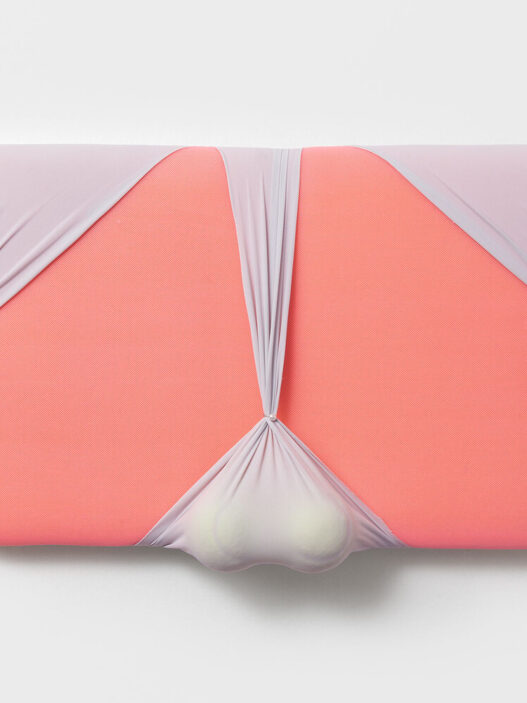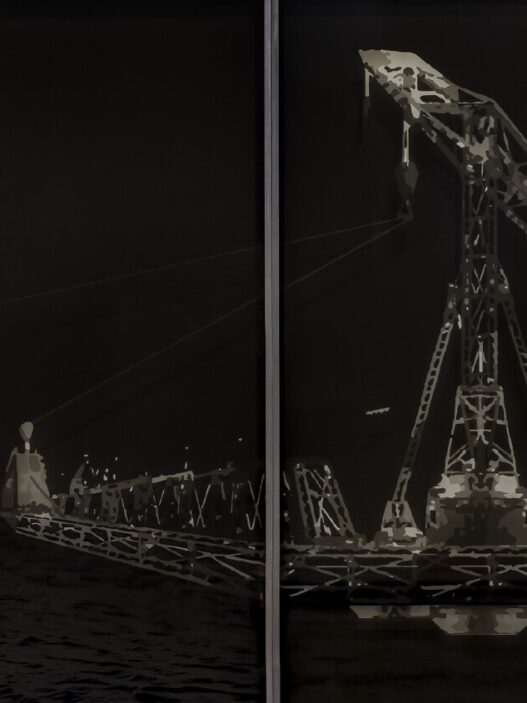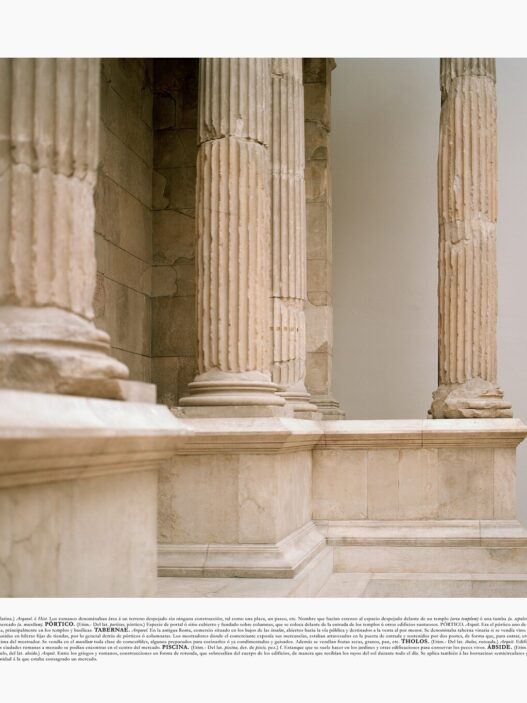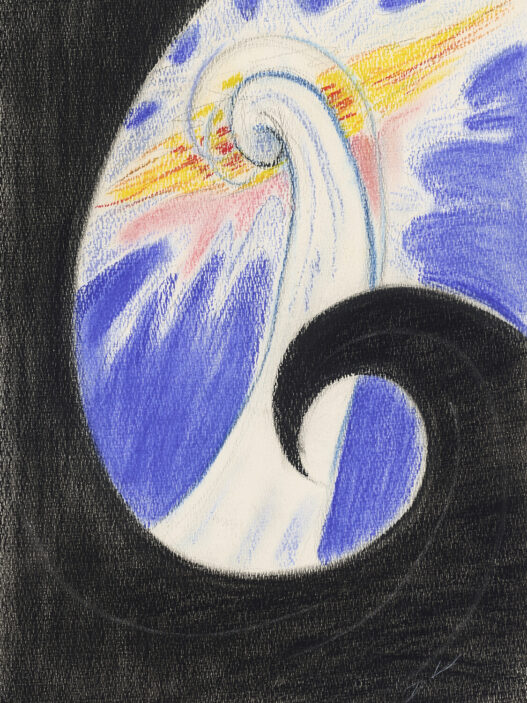At the end of May, Inhotim opens new artworks and temporary exhibitions. On May 28 the museum inaugurates the new season, which features Isaac Julien, invited to exhibit one of his most emblematic artworks. Acervo em Movimento (Collection in Motion), a program designed to share with the public the artworks recently included in the collection, opens with artworks by the Brazilian artists Arjan Martins and Laura Belém, both located in external areas of the Institute.
Jaime Lauriano also participates in the program, and opens the Inhotim Biblioteca (Inhotim Library) project, which each year will invite artists and researchers to create a conversation with the Institute’s library. The artist’s installation is directly related to the Second Act of the project Abdias Nascimento e o Museu de Arte Negra (Abdias Nascimento and the Black Art Museum), by proposing a curatorial approach for a new bibliography that includes black authors in the collection of the Inhotim library.
Located at Galeria Mata, the project’s Second Act, jointly curated, like the First Act, by Inhotim and IPEAFRO, addresses the Teatro Experimental do Negro (Black Experimental Theater), a movement headed by Abdias Nascimento, which is at the origins of the Black Art Museum.
The openings are part of Território Específico, the research axis that guides the Institute’s program in the biennium 2021–2022, aimed at fostering debates and reflections on the role of art in territories at the local and global levels, as well as on the relationship of institutions with their surroundings, focusing especially on the developments of a museum and botanical garden like Inhotim.
Galeria Praça: Isaac Julien
In an artwork that blends poetry and images, Isaac Julien draws on a lyrical exploration of the private world of the African-American poet, social activist, novelist, playwright and columnist Langston Hughes (1902–1967) and his fellow black artists and writers who shaped the Harlem Renaissance—a cultural movement based on African-American cultural expressions and which took place throughout the 1920s.
“In 1954, Langston Hughes exchanged letters with Abdias Nascimento, authorizing the Experimental Negro Theater to stage his plays. In this sense, Hughes, Nascimento and Isaac Julien, each at their own time, sought representation and recognition of black artistic and intellectual production”, explains Julieta González, Artistic Director of Inhotim.
Acervo em movimento (Collection in Motion): Arjan Martins and Laura Belém
There are latent concepts in the artwork of Arjan Martins, especially those involving migrations and other displacements of bodies and presences between spaces of struggle and power, as well as diasporas and colonial movements that took place in Afro-Atlantic territories.
In the Instalação de Birutas (Windsock Installation, 2021), Arjan shows devices intended to indicate the direction of the winds, which merge with maritime flags and their international codes to transmit messages between vessels and ports.
“By fusing these two elements—windsocks and nautical flags—Arjan addresses the transit of bodies across the oceans, the trafficking of enslaved people, as well as the diasporas caused by the colonial movements,” explains Douglas de Freitas, Curator at Inhotim.
On the lake between the Galeria Mata and True Rouge, visitors will come across two rowing boats equipped with spotlights, facing one another, on the water. The lights on one of the boats come on, while those on the other remain off. After 20 seconds, the process is inverted: the one that was lit up now goes off, and vice-versa. The lights on both boats are then turned on simultaneously and, at the end, they all turn off until the cycle restarts automatically. The piece is called Enamorados (Enamored, 2004), by Laura Belém, shown for the first time in 2004 in the Lagoa da Pampulha, in the city of Belo Horizonte (Minas Gerais / Brazil), and the following year at the 51st Venice Biennale.
“The idea of cycles—passage of time—and a certain fantastic theatricality are recurring elements in the artist’s production. In Enamorados, now installed on the lake in front of the True Rouge gallery, these elements are presented to create a narrative of flirtation, in which two bodies signal to one another, turning their lights on and off, communicating silently without ever touching,” reflects Freitas.
Collection in Motion emerged from Inhotim’s desire to be a breathing place, in constant transformation, making the new additions to the collection available to the public.
Inhotim Biblioteca (Inhotim Library): Jaime Lauriano
The research conducted by Jaime Lauriano seeks to bring to the surface historical traumas relegated to the past and to confined archives, in proposals for the collective revision and re-elaboration of History. Marking the opening of the Inhotim Biblioteca, the artist showcases an occupation to activate the Institute’s library, establishing a direct dialogue with the Second Act of Abdias Nascimento and the Black Art Museum—a project carried out by Inhotim in partnership with IPEAFRO, on view at the Mata.
“The proposal is to try to imagine possible libraries and how a library can unfold,” reflects Julieta González. “And the occupation is a way of activating it, in addition to serving as a resource for thinking about the relationship with local communities,” she adds.
Galeria Mata: Second Act of Abdias Nascimento and the Black Art Museum
Jointly curated with IPEAFRO (Institute for Afro-Brazilian Research and Studies), Inhotim hosts a museum within its space and features, in a period spanning two years, the project conceived by Abdias Nascimento (1914–2011) in the early 1950s: the Black Art Museum.
The exhibition offers audiences documents on the trajectory of the Black Experimental Theatre, paintings byNascimento and artworks by such artists as Anna Bella Geiger, Heitor dos Prazeres, Iara Rosa, José Heitor da Silva, Sebastião Januário, Octávio Araújo and Yêdamaria, who are part of IPEAFRO’s Black Art Museum collection.
Divided into eight chronological sections (1941 – Trip to Latin America / 1943 – Theater of the Sentenced / 1944 – Black Experimental Theatre / 1950 – 1st Congress of the Brazilian Negro / 1955 – Black Christ / 1968 – MAN at the Museu da Imagem e do Som of Rio de Janeiro January / 1966 – World Festival of Negro Arts, Dakar – Senegal / 1968 – Exile), the Second Act presents an extensive documentary research and proposes a new regard to the Black Art Museum’s collection, now under the care of IPEAFRO. The focus lies on the importance of the collection as a device for the appreciation and recognition of ancestral African values in Brazilian society.
The Black Experimental Theatre remained active until 1968 and it was during one event, the 1o Congresso do Negro Brasileiro (1st Congress of Brazilian Blacks), held in Rio de Janeiro in 1950, that the project for the Black Art Museum took shape.
According to Elisa Larkin Nascimento, author, curator and director of IPEAFRO, “the Second Act gets it right in proposing this dialogue between the documents in the collection, the paintings by Abdias Nascimento and the artworks gathered in IPEAFRO’s Black Art Museum collection. In this way we are able to show the political dimension of art and the curatorial approach proposed and carried out by Abdias Nascimento in the Black Art Museum project.”
“Abdias Nascimento’s painting refers to the origins of his personal growth as an artist and intellectual, which began in the 1930s. First in theater, acting and directing. Then, as curator of the Black Art Museum,” explains Julio Menezes Silva, curator at IPEAFRO.
Instituto Inhotim
Rua B, 20
Brumadinho-Minas Gerais
35460-000
Brazil
Hours: Tuesday–Friday 9:30am–4:30pm,
Saturday–Sunday 9:30am–5:30pm
T +55 31 3194 7328
imprensa@inhotim.org.br















